|
Have a safe day!
Friday, Jan. 16
3:30 p.m.
Director's Coffee Break - WH2XO
4 p.m.
Joint Experimental-Theoretical Physics Seminar - One West
Speaker: John Paul Chou, Rutgers University
Title: New Physics from CMS: Hints from Run 1 and Prospects for Run 2
8 p.m.
Fermilab Lecture Series - Ramsey Auditorium
Speaker: Dan Hooper, Fermilab
Title: Revealing the Nature of Dark Matter
Tickets: $7
Monday, Jan. 19
Holiday - Martin Luther King Jr. Day
Tuesday, Jan. 20
2 p.m.
Particle Astrophysics Seminar (NOTE DATE) - Curia II
Speaker: Irshad Mohammed, University of Zurich
Title: Towards Precision Cosmology: The Halo Model and Necessary Modifications
3:30 p.m.
Director's Coffee Break - WH2XO
THERE WILL BE NO ACCELERATOR PHYSICS AND TECHNOLOGY SEMINAR THIS WEEK
Visit the labwide calendar to view Fermilab events
|
|
Friday, Jan. 16
- Breakfast: chilaquiles
- Breakfast: chorizo and egg burrito
- Beer-braised bratwurst
- Roasted salmon caponata
- Barbecue grilled chicken
- Baked ham and cheese ciabatta
- Boneless wing bar
- Leek and potato soup
- Texas-style chili
- Assorted pizza by the slice
Wilson Hall Cafe menu
|
|
Friday, Jan. 16
Dinner
- Stuffed mushrooms
- Filet mignon with cabernet sauce
- Roasted new potatoes
- Green bean and blue cheese gratin
- Strawberry crepe
Wednesday, Jan. 21
Lunch
- Rouladen
- Buttered egg noodles
- Dilled baby carrots
- German chocolate cake
Chez Leon menu
Call x3524 to make your reservation.
|
|
Technical Division's new test stands operational
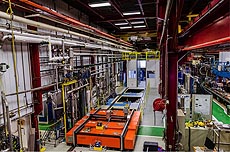 |
| This bird's eye view of the Vertical Cavity Test Area captures all three of Fermilab's vertical test stands, called VTS-1 (closest), VTS-2 and VTS-3 (farthest). The large orange concrete and steel radiation shield moves to cover the stand under test. To the left, vacuum and cryogenic transfer lines are used to prepare the test conditions. Farther left are the radio-frequency power, instrumentation and control. Cavities are prepared for testing in the white staging area. Photo: Ruben Carcagno, TD |
Late last month, two new world-class state-of-the-art test stands became operational in the Technical Division Test and Instrumentation Department.
These vertical test stands, or VTSs, allow scientists, engineers and technicians from the Technical Division SRF Development Department to make measurements of isolated superconducting radio-frequency cavities under carefully controlled conditions. They are also essential for production testing of SLAC's LCLS-II and Fermilab's PIP-II devices.
This project, which was the result of many years of hard work by contributors from around the lab and the globe, expanded the Vertical Cavity Test Facility from the original VTS-1 stand (completed in 2007) to include the two larger new stands, VTS-2 and VTS-3.
Further information about the project will be the topic of an upcoming Technical Division column.
|
Find out about DOE's new Lab-Corps - Jan. 20
If you have an idea for a new, marketable clean-energy technology, the Department of Energy's new Lab-Corps program could help you make it a reality.
Fermilab has partnered with Argonne National Laboratory, one of five sites chosen for the new program. Sponsored by the DOE's Office of Energy Efficiency and Renewable Energy, the Lab-Corps program will pair scientists and engineers with entrepreneurs to fast-track clean-energy technologies from the lab to the marketplace.
The Chicago Innovation Exchange will co-manage the program. Teams of scientists, engineers and business mentors will shepherd ideas through the proposal stage and, if selected, will compete in a Pitchfest event at Argonne in late March.
Fermilab will host an informational meeting about Lab-Corps on Tuesday, Jan. 20, at 2 p.m. in Curia II. The program is open to all technologies, regardless of funding source. If you are interested in attending, please contact Cherri Schmidt at x5178.
|
Superstrings
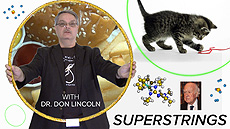 |
Scientists have put forward an intriguing proposal that all matter is composed of tiny "strings." Under this idea, known particles would be simply different vibrational patterns of these strings. U.S. CMS Education and Outreach Coordinator Don Lincoln explains this idea using examples of real-world vibrations. View the video. Video: Fermilab |
|
Graduate students sharpen their skills at CMS Data Analysis School
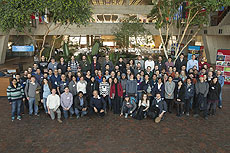 |
| Graduate students convened for one week at Fermilab for the fifth annual CMS Data Analysis School, hosted by the LHC Physics Center. Photo: Reidar Hahn
|
As the LHC accelerator is cooling down in Geneva, Switzerland, for the upcoming 2015 run, students have been warming up for the analysis of the new data that will come out of the CMS experiment.
From Jan. 12-16, about 50 graduate students from across the United States came to Fermilab to attend the fifth annual CMS Data Analysis School, hosted by the LHC Physics Center. They were coached by 55 CMS experts in hands-on sessions.
School attendees came to learn particle physics data analysis techniques, strengthen their skills in analysis and interact with CMS scientists to learn more about conducting the experiment.
They will contribute to the CMS experiment at the Large Hadron Collider when it turns on again in March after a two-year shutdown.
|
World's biggest magnet to power Indian neutrino hunter
From New Scientist, Jan. 14, 2015
Indian physicists are going underground. Their government has given the green light and $235 million funding to build the India-based Neutrino Observatory (INO), the country's first underground laboratory to study the weakly interacting, nearly massless subatomic particles.
The experiment will place a 50,000-tonne magnetic detector in a cave 1300 metres beneath Ino Peak in southern India. This will be the world's most massive magnet, outweighing the largest magnet at the Large Hadron Collider by a factor of four.
Read more
|
China breaks ground for second underground neutrino lab
From The Economic Times, Jan. 11, 2015
BEIJING: China has laid foundation stone for an underground laboratory which will be equipped with the world's most precise and biggest liquid scintillation detector for neutrino experiment.
The lab at Jiangmen in Guangdong province will be built 700 meters underground and put into operation in 2020, Wang Yifang, director of the Institute of High Energy Physics (IHEP) of the Chinese Academy of Sciences and the project's spokesman from the Chinese side said.
Read more
|
|
Stealth SUSY
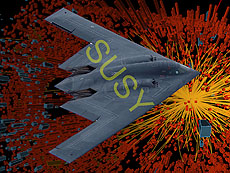 |
| Stealth SUSY is a theory of supersymmetry that doesn't have the usual signatures expected in more common supersymmetric models. Collisions in which stealth SUSY appears look much like the ordinary collisions of the Standard Model. A recent analysis studied CMS data to see if any evidence of stealth SUSY could be found. |
With the impending resumption of operations of the LHC, scientists often discuss what they think will be the next big discovery. While it is hard to make predictions, CERN odds-makers are leaning toward a discovery that incorporates supersymmetry, or SUSY, as the clear favorite.
Theories that incorporate SUSY can easily explain why the mass of the Higgs boson is so much lower than one would naturally expect. In fact, it is this aspect of SUSY that has intrigued physicists for decades, leading to more than 10,000 theoretical and experimental papers on the subject. Thus far, in spite of the best efforts by very smart people at both the Fermilab Tevatron and the CERN Large Hadron Collider, no experimental evidence has been found that SUSY is true.
Supersymmetric theories predict a whole class of supersymmetric particles that are cousins to the familiar particle of the Standard Model. In the most common models, these new particles are all unstable, except for the lightest supersymmetric particle (or LSP). From our measurements, we know that the LSP (if it exists) is massive, stable and electrically neutral. (The LSP is actually a leading candidate for dark matter, and this is another reason that SUSY is considered an attractive idea.)
LSPs do not interact very much with ordinary matter and thus will escape any particle collision that produces them without leaving a trace in a particle detector. Using the principle of momentum conservation, we know that the momentum perpendicular to the particle beams must be zero. If we add up the visible momentum and it isn't zero, we can infer that a particle escaped our detector. Given that LSPs can escape, events with a high momentum imbalance are ideal for searching for SUSY.
The problem is that we have studied events with these characteristics and have seen no evidence for the existence of SUSY. This has led theoretical physicists to invent new theories that predict little or no momentum imbalance. For instance, one such idea postulates that there exist new particles that interact very little with ordinary matter. In this model, the new particle and its supersymmetric cousin have very similar masses. This similarity in mass means that the LSP can have very little momentum, thus no striking momentum imbalance is expected. Theories with this property are generically called stealth SUSY.
CMS scientists studied a class of events with little missing momentum, the signature of W and Z bosons, along with jets from quark production, trying to see if they might find stealth SUSY. No evidence was found. This measurement was used to exclude some parameters in stealth SUSY models.
—Don Lincoln
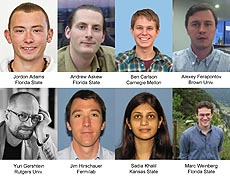 |
| These U.S. scientists contributed to this analysis. |
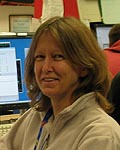 |
| Fermilab's Vivian O'Dell has been named the head of the U.S. CMS Phase 2 Project Office. |
|
Gossamery frost
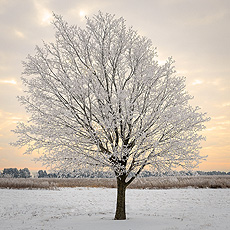 |
| Covered in hoar frost, this tree's slender, white branches give it a delicate appearance. Photo: Ruben Carcagno, TD |
|
|